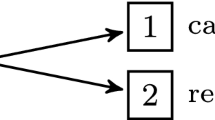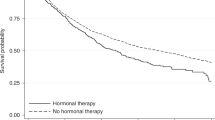Abstract
By far the most popular model to obtain survival predictions for individual patients is the Cox model. The Cox model does not make any assumptions on the underlying hazard, but it relies heavily on the proportional hazards assumption. The most common ways to circumvent this robustness problem are 1) to categorize patients based on their prognostic risk score and to base predictions on Kaplan-Meier curves for the risk categories, or 2) to include interactions with the covariates and suitable functions of time. Robust estimators of the \(t_0\)-year survival probabilities can also be obtained from a “stopped Cox” regression model, in which all observations are administratively censored at \(t_0\). Other recent approaches to solve this robustness problem, originally proposed in the context of competing risks, are pseudo-values and direct binomial regression, based on unbiased estimating equations. In this paper stopped Cox regression is compared with these direct approaches. This is done by means of a simulation study to assess the biases of the different approaches and an analysis of breast cancer data to get some feeling for the performance in practice. The tentative conclusion is that stopped Cox and direct models agree well if the follow-up is not too long. There are larger differences for long-term follow-up data. There stopped Cox might be more efficient, but less robust.








Similar content being viewed by others
References
Andersen PK, Keiding N (2012) Interpretability and importance of functionals in competing risks and multistate models. Statist Med 31:1074–1088
Andersen PK, Pohar Perme M (2010) Pseudo-observations in survival analysis. Statist Method Med Res 19:71–99
Andersen PK, Klein JP, Rosthøj S (2003) Generalised linear models for correlated pseudo-observations, with applications to multi-state models. Biometrika 90:15–27
Binder N, Gerds TA, Andersen PK (2013) Pseudo-observations for competing risks with covariate dependent censoring. Lifetime Data Anal. (In press) doi:10.1007/s10985-013-9247-7
Gerds TA, Scheike TH, Andersen PK (2012) Absolute risk regression for competing risks: interpretation, link functions, and prediction. Statist Med 31:3921–3930
Graw F, Gerds TA, Schumacher M (2009) On pseudo-values for regression analysis in competing risks models. Lifetime Data Anal 15:241–255
Grøn R, Gerds TA (2013) Binomial Regression Models. In: Handbook of survival analysis, Chapman & Hall/CRC, Boca Raton, pp 221–242. (Handbooks of modern statistical methods, chapter 11)
Logan BR, Wang T (2013) Pseudo-value regression models. In: Handbook of survival analysis. Chapman & Hall/CRC, Boca Raton, pp 199–219. (Handbooks of modern statistical methods, chapter 10)
Meijer R, Goeman JJ (2013) Model selection for high-dimensional models. In: Handbook of survival analysis. Chapman & Hall/CRC, Boca Raton, pp 301–322. (Handbooks of modern statistical methods, chapter 15)
O’Quigley J, Xu R (2013) Robustness of proportional hazards regression. In: Handbook of survival analysis. Chapman & Hall/CRC, Boca Raton, pp 323–339. (Handbooks of modern statistical methods, chapter 16).
Putter H (2013) Landmarking. In: Handbook of survival analysis. Chapman & Hall/CRC, Boca Raton, pp 441–456. (Handbooks of modern statistical methods, chapter 21).
Scheike TH, Zhang MJ (2007) Direct modelling of regression effects for transition probabilities in multistate models. Scandinavian J Statist 34:17–32
van Houwelingen HC (2007) Dynamic prediction by landmarking in event history analysis. Scandinavian J Statist 34:70–85. doi:10.1111/j.1467-9469.2006.00529.x
van Houwelingen HC, Putter H (2012) Dynamic prediction in clinical survival analysis. Chapman & Hall, Boca Raton
van Houwelingen HC, Stijnen T (2013) Cox regression model. In: Handbook of survival analysis. Chapman & Hall/CRC, Boca Raton, pp 5–25. (Handbooks of modern statistical methods, chapter 1)
Author information
Authors and Affiliations
Corresponding author
Rights and permissions
About this article
Cite this article
van Houwelingen, H.C., Putter, H. Comparison of stopped Cox regression with direct methods such as pseudo-values and binomial regression. Lifetime Data Anal 21, 180–196 (2015). https://doi.org/10.1007/s10985-014-9299-3
Received:
Accepted:
Published:
Issue Date:
DOI: https://doi.org/10.1007/s10985-014-9299-3




